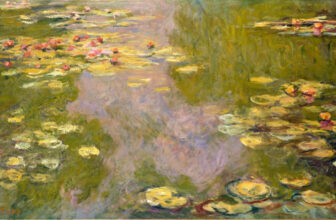
McSorley’s Bar: A Story of Camaraderie Through the Eyes of John Sloan
In the dimly lit, wood-paneled interior of a downtown tavern, time stands still. Smoke lingers in the air like a veil of memory, and warm amber light dances across worn tables and frothy mugs. This is not just any bar, it’s McSorley’s Bar, a haven for working-class men, immigrants, and neighborhood regulars. And in 1912, John Sloan immortalized this slice of New York life in a painting that would become one of the most enduring pieces of American realism.
McSorley’s Bar by John Sloan is not simply a painting; it is a narrative, a window into the soul of early 20th-century urban America. Through its earthy palette, intimate composition, and documentary-like clarity, Sloan brings viewers into the scene, not as observers, but as silent participants in the gritty warmth of a bygone era.
McSorley’s Old Ale House, located in Manhattan’s East Village, is more than just the oldest continually operating bar in New York City, it is a cultural landmark. Since its establishment in 1854 (or perhaps earlier; the records are hazy), it has welcomed generations of patrons, from Abraham Lincoln to E.E. Cummings. By the time Sloan walked through its doors in the early 1900s, McSorley’s had already cultivated a mythology of its own. It was a place of loyalty, community, and unpretentious simplicity. Women were not even allowed until 1970.
John Sloan, a leading figure of the Ashcan School, saw in McSorley’s a reflection of the people he painted: ordinary, often overlooked, but vibrant and dignified. When he painted McSorley’s Bar, he wasn’t just depicting a location, he was painting a way of life on the brink of transformation.
What Is Happening in McSorley’s Bar?
The painting depicts the interior of the ale house during what seems to be a calm afternoon. Two bartenders serve drinks behind the counter while two patrons, absorbed in their drinks and conversation, sit at a nearby table. The bar is cozy but cluttered, with sawdust scattered on the floor, steins hanging from the ceiling, and objects like a black cat, a stove, and old signs visible in the background.
The lack of dramatic action is crucial. Sloan wasn’t interested in the sensational, he found poetry in the mundane. This painting, like much of his work, is rooted in observation rather than imagination. He presents life as it is: honest, unglamorous, and textured with unspoken stories.
The figures in the painting do not pose for the viewer. They are wrapped in their own world, interacting naturally with their surroundings. This sense of spontaneous realism gives the painting a documentary quality, an archival snapshot frozen in paint.
Type of Art: The Ashcan School and American Realism
To understand McSorley’s Bar, it is essential to place it within the broader context of the Ashcan School, a movement of early 20th-century artists known for their gritty depictions of urban life. The Ashcan School, often linked with artists like Robert Henri, George Bellows, and Everett Shinn (many of whom were Sloan’s contemporaries), sought to break away from academic and impressionistic norms, favoring instead the raw, immediate experience of the city.
Unlike their European counterparts, Ashcan artists weren’t painting idealized landscapes or aristocratic portraits. They painted crowded tenements, street vendors, alleyways, and bars, real people in real places.
Sloan’s McSorley’s Bar is a quintessential example of this approach. Its visual honesty, subdued colors, and lack of idealization are all hallmarks of Ashcan realism. But what makes it truly powerful is not just its fidelity to life, but its empathy. Sloan doesn’t simply show us a bar; he invites us to feel its atmosphere, to breathe its air, and to hear the murmur of voices and the clink of glasses.
Symbolism and Interpretation
While McSorley’s Bar appears straightforward at first glance, it is rich in symbolism and layered interpretation.
1. The Bar as a Social Microcosm
At its core, the painting represents the bar as a democratic space, a social equalizer where men of all classes and backgrounds gather. In the early 20th century, taverns were central to the fabric of working-class communities, serving as places of solidarity, escape, and conversation. McSorley’s in the painting is a sanctuary from the noise and chaos of the outside world, a stable refuge in an ever-changing city.
2. The Passage of Time
McSorley’s is depicted as cluttered with artifacts: steins, pictures, clocks, and signs. These objects, seemingly insignificant, are symbols of accumulated memory. The bar becomes a repository of time, preserving the lives and stories of its patrons. The use of shadow and subdued light evokes nostalgia, a yearning for a simpler, slower era.
3. Masculinity and Gender Exclusion
The painting reflects a world occupied solely by men. At the time, McSorley’s did not allow women, this absence is striking in the composition. It captures a moment in gendered social history where the male camaraderie of the bar was both a cultural norm and a closed circle. Today, this exclusion reads as a poignant artifact of its time.
4. Simplicity as Virtue
The unpretentious nature of the bar and its patrons may be read as a quiet critique of the increasing materialism and social stratification of American society in the early 20th century. In Sloan’s McSorley’s, there is no pretense. There is humility and authenticity, a celebration of ordinary life.
Sloan’s Artistic Choices: Composition, Color, and Technique
John Sloan was a master of subtle composition. In McSorley’s Bar, the lines of the bar counter, stools, and hanging objects draw the eye inward, creating depth without grandeur. The muted, earthy palette, browns, ochres, grays, mirrors the physical and emotional warmth of the setting. Sloan used oil on canvas, applying the paint with confidence but without flourish. There is no evidence of ego in the brushwork; the strokes serve the story, not the painter.
One notable feature is the interplay of light and shadow. The lighting isn’t dramatic, but it’s purposeful. It gently highlights the key elements, the patrons, the bartenders, the bar top, guiding our attention while preserving the overall harmony of the piece.
Sloan also avoids sentimentality. He doesn’t romanticize the bar or idealize its customers. Instead, he renders them with quiet dignity, allowing their posture, clothing, and interactions to speak for themselves.
Where Is McSorley’s Bar Painting Today?
John Sloan’s McSorley’s Bar is currently housed in the Detroit Institute of Arts (DIA), one of the most prestigious art museums in the United States. The painting remains one of the DIA’s treasured works, particularly within its collection of American art. It stands not only as a significant artistic achievement but also as a historical document of an era and a place that continues to inspire curiosity and affection.
For those who wish to see the real McSorley’s, the bar itself still operates at 15 East 7th Street in Manhattan. Walking through its doors today, one still finds many of the details Sloan painted more than a century ago: the sawdust on the floor, the ale served in mugs, and the stories whispered from wall to wall.
The Legacy of McSorley’s Bar
In many ways, McSorley’s Bar transcends its time. It is not merely about 1912 New York, it’s about community, belonging, and the fleeting nature of ordinary moments. Sloan’s painting is a meditation on everyday life and a reminder that beauty and meaning often reside in the simplest places.
For modern viewers, the painting can evoke a sense of nostalgia for a pre-digital age, when human connection was forged face-to-face, across a shared table or a shared drink. In an era obsessed with innovation and speed, Sloan’s work encourages us to slow down and notice the details: the quiet conversation between friends, the gentle curve of a beer glass, the weight of a warm, familiar space.
Art critic Robert Hughes once said that “realism is not a style but a belief in the artist’s obligation to the truth.” If that is true, then McSorley’s Bar is among the most honest paintings in American art history. It doesn’t seek to dazzle, but it does endure, because it tells the truth of a particular moment, a particular place, and a particular people.
John Sloan’s McSorley’s Bar is far more than a portrait of a pub. It is a richly layered, emotionally resonant work that invites us into the soul of a city. It captures a New York before the skyscrapers rose, before the neighborhoods gentrified, before the modern world reshaped the rhythms of daily life. And yet, it remains strikingly relevant.
In that smoky barroom, among men lost in their mugs and conversation, we find ourselves. We find the need for connection, the beauty in the ordinary, and the power of art to freeze time, even just for a moment.
In the end, perhaps Sloan’s greatest achievement is not that he painted McSorley’s, but that he made us feel as though we had been there, too.




